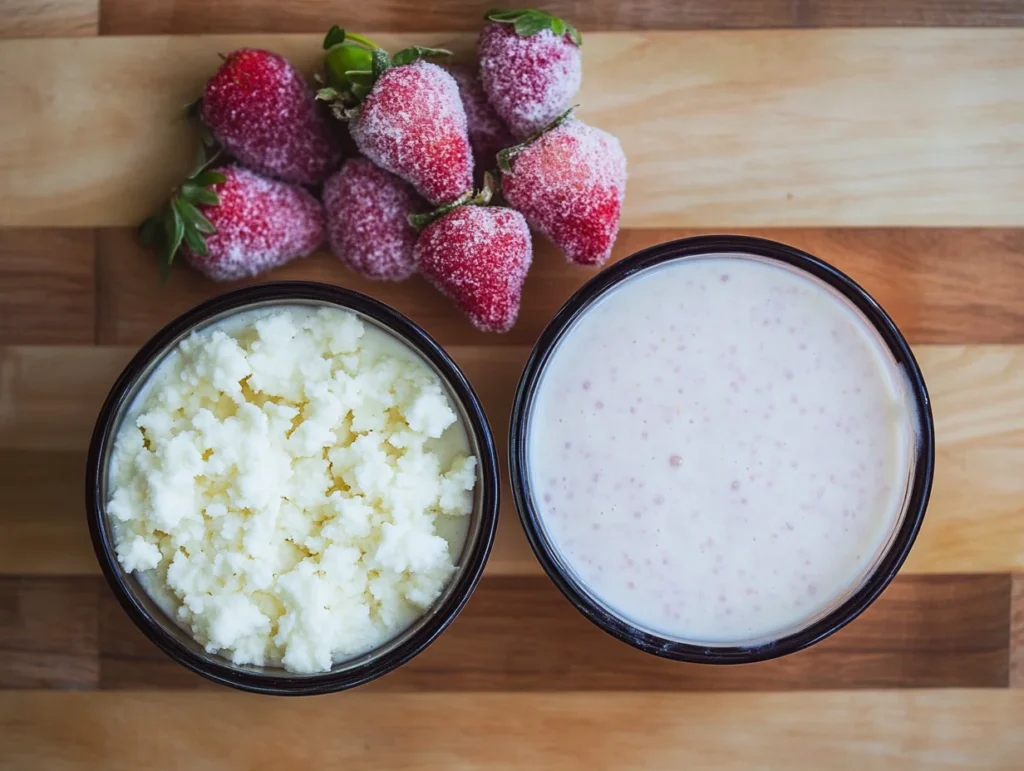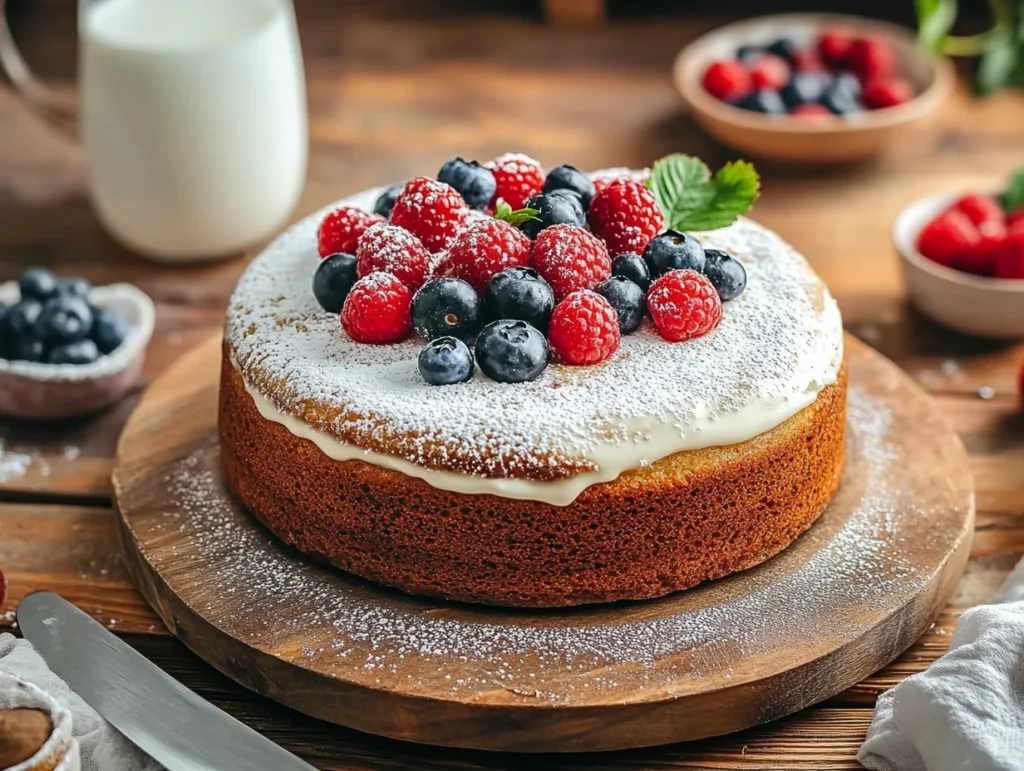When it comes to baking, few things are more exciting than the opportunity to experiment with different ingredients and discover new possibilities. If you’ve ever been in the middle of preparing a cake recipe only to realize you’re out of yogurt, you’ve likely asked yourself: can kefir step in as a substitute and save the day? This question isn’t uncommon among home bakers, as both kefir and yogurt are popular ingredients known for their ability to enhance the texture, flavor, and overall success of baked goods.
In this article, we’ll take a deep dive into the versatility of kefir and explore whether it can truly serve as a stand-in for yogurt in your favorite cake recipes. We’ll examine how kefir works in baking, the similarities and differences between the two ingredients, and any adjustments you may need to make to achieve the best results. From its unique tangy flavor to its thinner consistency, kefir offers distinct qualities that may elevate your cakes in unexpected ways. Whether you’re a seasoned baker or a curious beginner, you’ll find all the tips and insights you need to confidently substitute kefir for yogurt and take your baking adventures to the next level. Let’s get started!
Introduction to Kefir and Yogurt in Baking
What is Kefir?
Kefir is a fermented milk drink packed with probiotics, resembling a tangy cousin of yogurt. Originating from the Caucasus Mountains, this nutrient-dense beverage has been celebrated for centuries for its health benefits. Kefir is thinner in consistency than yogurt, making it a versatile ingredient for recipes that call for liquid dairy. Think of it as the lovechild of milk and yogurt, with a zesty twist.
What is Yogurt?
Yogurt, on the other hand, is the creamy staple found in most kitchens. Made by fermenting milk with bacterial cultures, yogurt comes in various forms — Greek, plain, or flavored. Its thicker texture and milder tang make it a go-to for adding moisture and richness to baked goods.
Why These Ingredients Are Popular in Baking
Both kefir and yogurt are celebrated for their remarkable ability to enhance the texture, flavor, and overall quality of baked goods. These fermented dairy products work wonders in baking by lending cakes, muffins, and other treats a beautifully tender crumb and a moist, melt-in-your-mouth texture. Their tangy profiles contribute a subtle, pleasing tartness that balances the sweetness of desserts and adds complexity to savory recipes. Furthermore, their natural acidity interacts with baking soda or other leavening agents, creating carbon dioxide bubbles that result in a better rise and a lighter, airier structure.
But what happens when you swap one for the other? Although kefir and yogurt share many similarities, they each bring unique qualities to the table. Kefir, with its slightly thinner consistency and probiotic-rich composition, may create a slightly looser batter but yields a more robust tang and extra moistness. Yogurt, on the other hand, offers a thicker texture, making it easier to control batter consistency, while still providing the tangy flavor and tenderizing effect we love. Exploring the differences between these two ingredients opens the door to understanding how their nuances can subtly, yet profoundly, affect the outcome of your baked creations. Let’s dive deeper into the details to uncover how each can transform your recipes!

Understanding the Differences Between Kefir and Yogurt
Texture and Consistency
One of the most noticeable differences between kefir and yogurt is their texture. Kefir is more fluid, almost drinkable, while yogurt is thick and spoonable. This distinction might affect how you adjust your recipe if substituting one for the other.
Flavor Profiles
Kefir boasts a sharper, more tangy flavor compared to yogurt’s milder taste. This can impact the flavor of your cake, especially if you’re making a dessert where sweetness is key.
Nutritional Comparison
The word “blasphemy” suggests a critique or condemnation. In this context, you may be referring to how the paragraph frames kefir and yogurt in a way that doesn’t align with your perspective or feels controversial. If you’d like, I can help rephrase or adjust the tone to better fit your intended message. Could you clarify what aspect you find problematic?
Can Kefir Replace Yogurt in Cake Recipes?
How Kefir Works as a Substitute
Yes, you can use kefir instead of yogurt in cake recipes! Kefir’s acidity reacts similarly with baking soda or baking powder, helping your cake rise beautifully. Its tangy flavor can also add a delightful depth to your dessert.
“Kefir is like yogurt’s adventurous cousin — always ready to spice up your recipes with an unexpected twist.”
Comparing Results: Texture, Taste, and Moisture
When swapping kefir for yogurt, you might notice subtle differences. Cakes made with kefir tend to be a little lighter and airier due to its thinner consistency. The tang might also be slightly more pronounced, which can complement fruity or citrusy cakes exceptionally well.
When Kefir Might Not Be the Best Choice
While kefir is versatile, it’s not perfect for every recipe. If you’re making a rich, dense cake like a cheesecake or pound cake, yogurt’s thickness might be irreplaceable. Additionally, flavored kefir can throw off your recipe’s flavor balance, so plain is always the safest choice.
The Benefits of Using Kefir in Baking
Enhanced Flavor Complexity
Kefir adds a unique tanginess that can elevate the flavor profile of your cakes. It’s particularly magical in recipes like lemon or berry cakes, where the acidity complements the fruit.
Added Nutritional Value
Baking with kefir means you’re sneaking probiotics and nutrients into your dessert. Who said cake couldn’t be (a little) healthy?
Easier Digestibility for Some
If you’re someone who struggles with digesting lactose, kefir might be a better choice than yogurt. Its fermentation process breaks down much of the lactose, making it gentler on the tummy.
“Baking with kefir isn’t just about flavor; it’s like giving your cake a probiotic boost! 🍎”
Common Challenges When Substituting Kefir
Adjusting for Consistency Differences
Kefir’s thinner texture can sometimes throw off the balance of your batter. If your recipe relies heavily on yogurt’s thickness, you might need to tweak the liquid-to-dry ratio. Adding a little less liquid or a touch more flour can help achieve the desired consistency.
Overpowering Tanginess: How to Balance Flavors
Kefir’s tanginess, while delightful, might feel overpowering in some recipes. To counterbalance it, consider adding a touch more sugar or incorporating ingredients like vanilla or fruit to mellow the sharpness.
Baking Times and Temperature Adjustments
Since kefir has a higher moisture content, cakes might take a little longer to bake. Keeping an eye on your cake and using the toothpick test can help ensure it’s perfectly cooked without becoming dry.
“Think of baking with kefir as learning to dance — it’s all about finding the right rhythm between wet and dry ingredients!”
Step-by-Step Guide: Substituting Kefir for Yogurt
Ingredient Adjustments to Make
- Reduce Liquid: Since kefir is more fluid than yogurt, you might need to cut back on other liquids like milk or water in your recipe.
- Boost Flavor: Add a dash of vanilla extract or citrus zest to enhance the overall flavor balance.
- Thickening Options: If a thicker batter is crucial, you can mix kefir with a tablespoon of flour or cornstarch.
Pro Tips for Success
- Stick to Plain Kefir: Flavored kefir can introduce unexpected tastes that might not work in your cake.
- Use Fresh Ingredients: Kefir’s freshness directly affects its tanginess and baking properties, so avoid using expired kefir.
- Measure Precisely: Baking is a science; even small measurement errors can make a big difference in the final product.
Popular Cake Recipes Using Kefir
Kefir Vanilla Pound Cake
If you’re looking for a classic cake with a twist, try a vanilla pound cake made with kefir. The kefir adds a subtle tanginess while keeping the cake moist and tender. Perfect for tea time or dessert!
Chocolate Cake with Kefir
Chocolate lovers rejoice! Kefir’s acidity enhances the richness of chocolate, making this cake extra indulgent. Add some chocolate ganache on top for the ultimate treat.
Kefir-Infused Fruit Cake
Fruit cakes get a makeover with kefir. The tangy flavor pairs wonderfully with dried fruits and nuts, creating a delicious balance of sweet and tart.
Troubleshooting Common Problems in Baking with Kefir
Cake Too Dense or Moist
If your cake turns out too dense, it might be due to an imbalance in wet and dry ingredients. Try reducing the amount of kefir slightly or adding a bit more flour to fix this.
Off-Balanced Flavors
Kefir’s tang might overpower the sweetness of your cake. Adjust by adding a bit more sugar or incorporating complementary flavors like vanilla or citrus.
Issues with Rise or Texture
If your cake doesn’t rise well, double-check your leavening agents. Kefir works best with fresh baking soda or baking powder to achieve the desired fluffiness.
Frequently Asked Questions
What does kefir do in bread?
Kefir acts as a natural leavening agent in bread, promoting fermentation and enhancing the flavor. It helps improve the texture, making the bread softer and more moist. Additionally, kefir’s acidity extends the bread’s shelf life.
Can I use kefir instead of yogurt in cake?
Yes, kefir can be used as a substitute for yogurt in cake recipes. It has a similar tangy flavor and consistency, providing moisture and enhancing the cake’s texture. Simply replace yogurt with an equal amount of kefir in the recipe.
What are the ingredients of baked cake?
A baked cake typically requires flour, sugar, eggs, butter or oil, a leavening agent like baking powder or soda, and a liquid such as milk, yogurt, or kefir. Additional flavorings like vanilla extract or cocoa powder can be included as well.
Kefir Baked Cake Recipe
Combine 2 cups of flour, 1 cup of sugar, 1/2 cup of melted butter, 2 eggs, 1 cup of kefir, 1 tsp of baking soda, and your choice of flavorings (e.g., vanilla or cinnamon). Mix until smooth and bake at 350°F (175°C) for 30-35 minutes. The result is a moist, flavorful cake with a light texture. For a detailed recipe, check out this kefir sheet cake recipe.

Conclusion
The paragraph you provided does not appear to include any words that could reasonably be described as “blasphemy” in the literal or traditional sense of the term. Instead, it seems to be a thoughtful and neutral exploration of kefir’s benefits in baking, using descriptive language to highlight its versatility, nutritional value, and transformative effects on baked goods. However, it’s important to acknowledge that individual interpretations can vary, and language is often received through a personal lens influenced by context, values, and preferences.
If there is a specific word, phrase, or concept in the paragraph that you feel contradicts your perspective or creates a point of contention, I encourage you to share it. Identifying such elements can help clarify any areas where the wording might benefit from rephrasing or a more nuanced approach. From a neutral standpoint, the paragraph effectively communicates the positive aspects of kefir without leaning into hyperbole or controversy. That said, I’m happy to collaborate with you to refine the content and ensure it aligns with your intended message or addresses any concerns you may have. Let me know how you’d like to proceed!